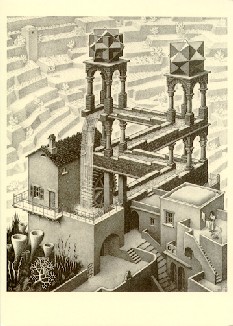

|
One of Escher's marvelous impossible buildings. The basis of the illusion is the inclusion of the impossible triangle or tri-bar, developed by Roger Penrose and his father. Escher also used this principal in Ascending/Descending, The Impossible Staircase. The triangle is placed into the picture three times. As you look at each part of the construction in the print you cannot find any mistakes, but when the print is viewed as a whole you see the problem of water traveling up a flat plane, yet the water is falling and spinning a miller's wheel. How do the two towers appear relatively the same height yet the left side rises three stories and the right two? Why did Escher chose to use underwater plant life, greatly magnified, as his choice for an above watergarden? The illusion in this print, when viewed by most people, is not seen on the first look. This is the perfect example of why Escher's work deserves that second look.